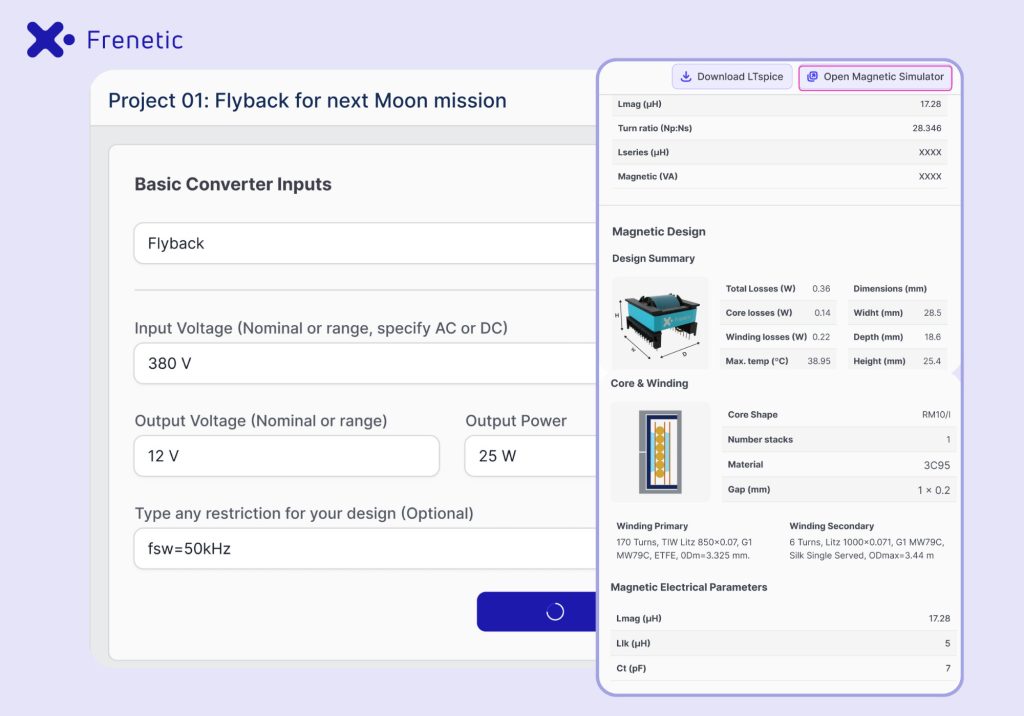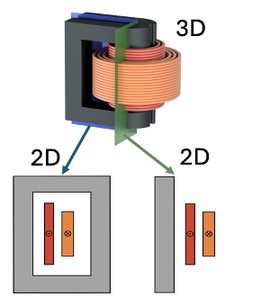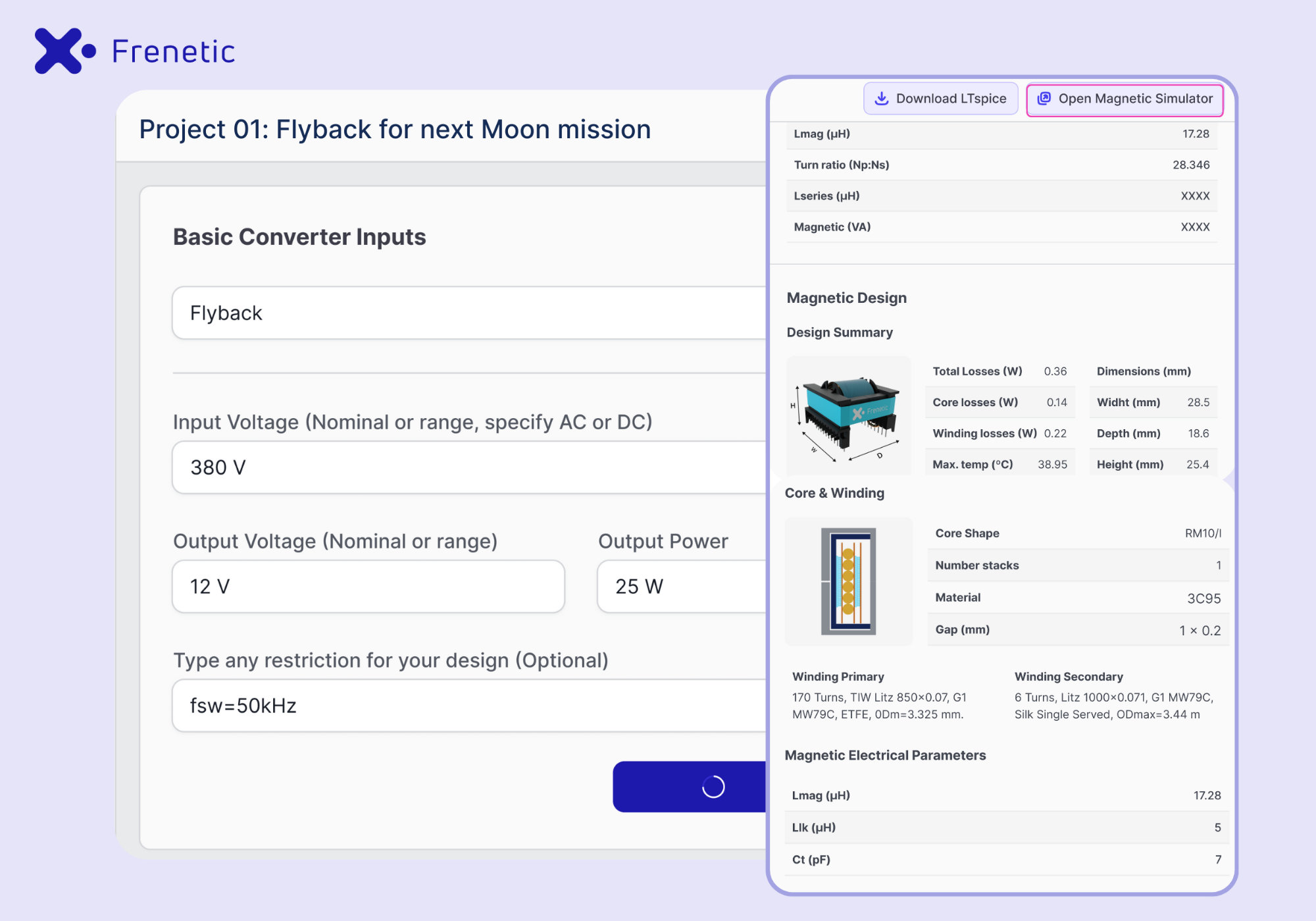Frenetic Electronics, a leader in cloud-based magnetics design, has unveiled its latest innovation: Frenetic AI, an advanced assistant that leverages artificial intelligence and machine learning to transform the design of power converters.
This innovative tool promises to accelerate the design process from hours to minutes while maintaining exceptional accuracy. Alongside Frenetic AI, the company has introduced significant upgrades to its Frenetic Magnetic Simulator, further solidifying its position as a pioneer in high-frequency magnetics design.
At first glance, magnetic components like inductors and transformers might seem like niche hardware tucked away inside power converters. But for engineers, they’re often the hardest—and slowest—parts to design correctly. That’s exactly the problem Frenetic set out to solve.
Founded in 2015, Frenetic specializes in high-frequency magnetic component design. Its cloud-based tools combine AI, machine learning, and lab-validated models to deliver speed and precision. Trusted by industries ranging from automotive to aerospace, Frenetic is redefining magnetic design for modern power electronics.
In this article, Dr. Chema Molina, founder and CEO of Frenetic, will explain how the company’s AI-powered assistant tool can help engineers to accelerate and simplify the design of magnetics and power supplies.
A smarter way to design
Rather than relying on the traditional method of spreadsheets, manual calculations, and separate simulation software, Frenetic’s approach begins and ends in the cloud. Users simply input their power converter specifications and the AI handles the rest.
In minutes, the tool generates a complete electrical schematic, a bill of materials, simulation files compatible with LTspice and PLECS, and recommendations for off-the-shelf or custom magnetic components. For experienced engineers, there’s full access to tweak and refine parameters. For newcomers or those facing a tight deadline, Frenetic AI offers a hands-free design path that’s still accurate and reliable.
Behind the scenes, large language models (LLMs) help the system understand user inputs, even if they’re vague or typed in plain English. Ask for “a high-efficiency topology under 50 mm height,” and Frenetic AI knows what to do.
Dr. Chema Molina highlights the tool’s efficiency: “Frenetic AI turns a multi-hour design process into an intuitive workflow, enabling engineers to move from specs to simulation in minutes.” The platform caters to both basic users, who receive automated magnetic specifications, and advanced users, who can delve into detailed customization and simulation options.
Currently available as a free Basic version, already tested by thousands of engineers worldwide, Frenetic AI will soon launch a PRO version with premium features like planar transformer design, off-the-shelf component suggestions, and enhanced design insights. The tool can operate as a standalone module or integrate with the Frenetic Magnetic Simulator for advanced magnetic component design.
Magnetic simulation
Frenetic’s upgraded Magnetic Simulator (Figure 1) has undergone a major evolution. Its simulation engine now includes a machine-learning-based model for calculating complex foil winding losses, one of the most elusive variables in magnetic design. This model was trained on over 5,000 FEM simulations and cross-verified with lab data, delivering remarkably accurate results with a median error of just 12%.
That level of fidelity is especially important for high-frequency designs, where precision is key to preventing overheating, inefficiency, or failure. Frenetic backs up its claims with a dedicated in-house lab, testing its models against real transformers and inductors built to spec.
This model achieves a median relative error of just 12% and delivers results in milliseconds. Dr. Molina emphasizes the simulator’s impact: “Professionals spend up to eight hours daily using Frenetic Simulator, running hundreds of simulations to optimize designs for specific applications, such as CLLC converters or high-isolation requirements.”

Figure 1: A screenshot of Frenetic’s updated Magnetic Simulator (Source: Frenetic Electronics)
Thermal, foil winding losses, and leakage inductance models
As excessive temperatures can lead to device destruction or loss of magnetic material properties, Frenetic has also developed an accurate thermal model. It ensures designs operate within a safe temperature range and accurately assesses core and winding losses, which are temperature-dependent.
The model utilizes a simplified lumped circuit approach, incorporating heat transfer mechanisms like conduction, radiation, and natural/forced convection. These mechanisms are accounted for using established physical and empirical formulas, which are then refined with machine learning to suit power magnetic components.
A machine learning model has also been developed to predict foil winding losses, which are a significant challenge in high-frequency power electronics design. The model combines the accuracy of numerical simulations with the speed of AI.
Frenetic’s approach involves generating highly accurate synthetic data through numerical simulations using FEMM software for 5,000 diverse foil setups, including various design features (foil dimensions, window dimensions, and gap distributions) and frequencies from 50 Hz to 500 kHz.
Leakage inductance is a critical parameter in various power electronics topologies, such as flyback, dual active bridge, and resonant converters, influencing switching behavior, overvoltage, and losses. Frenetic’s Quasi-3D (Q3D) leakage inductance model (Figure 2) is based on splitting the 3D transformer geometry into multiple winding sections with constant 2D cross-sections. The magnetic energy contributions from all winding sections are calculated and summed to determine the overall magnetic energy, from which the total leakage inductance is derived.

Figure 2: Frenetic’s quasi-3D modelling concept (Source: Frenetic Electronics)
Industry adoption
Frenetic AI is designed to streamline the entire power supply design process, from topology selection to component sourcing. The tool’s integration with LLMs (Large Language Models) allows it to interpret user inputs naturally, even suggesting designs based on specific control chips like those from Infineon or Texas Instruments.
Additionally, Frenetic is collaborating with component vendors to include their catalogs directly in the platform, enabling engineers to generate complete bills of materials and even export designs to FEM environments for advanced validation.
The platform has already gained traction across industries, particularly among magnetic component manufacturers, power supply designers, and aerospace companies. Dr. Molina notes, “We see daily use cases, such as engineers designing complete flyback converters or optimizing magnetics for space applications, where our temperature models excel in vacuum conditions.”
Engineers working in mission-critical environments, like aerospace and satellite systems, are already putting these tools to work. According to Molina, organizations such as NASA’s Jet Propulsion Laboratory and the European Space Agency (ESA) have become frequent users, particularly drawn to the platform’s ability to simulate temperature behavior in vacuum environments.
The future is automated
Frenetic AI has the ability to automate the tasks that engineers often don’t talk about, that is, the tedious but necessary work of searching compatible ICs, validating footprints, selecting off-the-shelf components, and organizing BOMs.
Now, all of that is built into the workflow. The AI assistant doesn’t just recommend a component, it understands the topology, checks the fit, considers the constraints, and pulls from real vendor catalogs. In fact, Frenetic is collaborating with manufacturers to embed their parts directly into the platform, creating a more connected, intelligent component ecosystem.
Engineers can even export their projects into tools like KiCad, giving them a clear path from simulation to PCB layout. While the AI doesn’t yet complete the board design itself, it provides everything needed for the next step, such as schematic, layout-ready footprints, and component models included.
According to Molina, the vision is clear: “Magnetic design shouldn’t be a bottleneck. It should be part of a broader, connected design ecosystem that lets engineers move fast, iterate confidently, and innovate freely.”
The future of AI in electronics design
Looking ahead, Frenetic envisions a future where AI automates repetitive tasks, allowing engineers to focus on innovation. Dr. Molina explains, “With tools like Frenetic AI, engineers can simply request a sweep analysis and receive results instantly, boosting productivity exponentially.” The company is also working to make its design algorithms transparent, publishing equations and methodologies for each topology to foster trust and collaboration within the engineering community.
“Soon, tasks that take days today—running design sweeps, generating comparative analysis, optimizing across multiple topologies, will be handled in seconds by AI agents,” said Molina. “We’re already seeing it happen.”
With the magnetic domain now firmly in the AI age, Frenetic is inviting engineers to explore a faster, smarter, and more accurate way of building power electronics. The company offers webinar clips, demo videos, and live demo environments upon request. As Frenetic continues to bridge the gap between conceptual design and FEM-level verification, it is clear that the era of AI-driven magnetic design has arrived.


